Posts Tagged: Richard Molinar
California drought and the fate of the state’s beloved berries

To find out, farm advisors around the state are comparing strawberries, blueberries and blackberries grown under four irrigation regimes – one that reflects the normal practice, one half the normal amount of water, one 75 percent of normal, and one that is 25 percent more than normal. The studies are being conducted in Santa Clara, San Luis Obispo, San Diego and Fresno counties.
“We’re doing this because of the water issue in California,” said Richard Molinar, UC Cooperative Extension advisor in Fresno County. “We’re in drought mode. We want to look at ways farmers can cut back the amount of water they are using and still have good tasting berries.”
Molinar recently brought samples of strawberries grown at the UC Kearney Agricultural Research and Extension Center in Parlier to the Vineyard Farmers Market in Fresno and invited patrons to share their preferences. Strawberry tasters were asked to evaluate the fruits’ appearance, flavor and texture. The advisors will aggregate information from taste testing done on berries from all the research sites.
The research will go beyond consumers’ preferences. Beth Mitcham, UCCE specialist in the Department of Plant Sciences at UC Davis, will evaluate the fruit grown under different irrigation regimes in the laboratory. Mitcham’s research will determine the amount of sugar, the sugar-acid ratio and the amount of antioxidants in the fruit and how these are affected by increasing or decreasing the usual amount of irrigation water.
The study is funded with a specialty crops grant from the California Department of Food and Agriculture awarded to the small farm program under the direction of Shermain Hardesty, UC Cooperative Extension specialist in the Department of Agricultural and Resource Economics at UC Davis.
See video of the strawberry tasting here:
UCCE makes Southeast Asian vegetables easy to eat

At certain roadside stands, at farmers markets that cater to diverse clientele and in small Asian supermarkets, adventurous Californians can buy vegetables like bitter melon, Chinese long beans, opo and luffa. Finding them is the first step, knowing how to prepare them is another matter. UC Cooperative Extension has made these less familiar vegetables more accessible by creating a collection of easy-to-cook and nutritious Southeast Asian vegetable recipes.
The recipes were developed by UCCE nutrition educators in Fresno and the statewide UC Expanded Food and Nutrition Education Program team with Richard Molinar, a UCCE advisor in Fresno County. Connie Schneider, director of the UC Youth, Families and Communities Program, and Molinar started by researching the traditional usage of Asian vegetables. They modified some ingredients and procedures in the recipes to simplify preparation and improve the nutritional profile.
“We minimized the number of ingredients in each recipe, added clear measurements and tested the dishes,” Schneider said. “They are delicious.”
For the last 18 years, Molinar has worked with small-scale farmers in Fresno County, which boasts the largest concentration of Hmong farmers in the U.S. Fresno County is also home to farmers of other ethnicities from Laos, China and Vietnam. Molinar and his assistant, Michael Yang, have introduced Southeast Asian immigrant farmers to the latest farming technologies, helped them develop plans to ensure the safety of the food they grow, and worked with them to find new marketing opportunities. Many of these farmers have begun growing vegetables common in California, and most have also kept some space on the farm for the vegetables of their homelands.
The UCCE educators recognized that the rich culinary traditions of local Southeast Asian immigrants could be adapted and used by people of all cultures to increase their consumption of vegetables. Besides, encouraging consumption of Southeast Asian vegetables adds new marketing opportunities for the farmers.
“This has been a unique opportunity to bring UCCE’s farm advisors and nutrition educators together to assist farmers and the public,” Molinar said. “These recipes will encourage more people to buy these nutritious vegetables, expanding the market for the growers.”
The 12 recipes are printed on cards, each with photos of the fresh vegetable and background information. For example, the recipe card for “bitter melon stir fry” notes that the crinkly skinned vegetable is native to India and is eaten when young and green, as bitterness increases with age. The recipe is accompanied by a photo of the prepared dish and complete nutrition facts per serving.

"I grew up with zucchini," Molinar said, "but I prefer the flavor and texture of angled luffa."
The printed cards will be distributed at farmers markets where Southeast Asian vegetables are sold, and they are available on the Fresno County UC Cooperative Extension website. Farmers who sell Asian vegetables at farmers markets may pick up 10 packets of recipes for free at the UC Cooperative Extension in Fresno, 1720 S. Maple Ave., Fresno. Direct links to each of the recipes are below:
- Bitter Melon Stir Fry
- Chinese Long Bean and Tofu Salad
- Chinese Winter Melon Chicken Soup
- Field of Greens Salad
- Fuzzy Gourd Stuffed with Pork and Mushrooms
- Lemongrass Chicken Soup
- Luffa and Prawns
- Marinated Japanese Eggplant
- Opo and Beef
- Snow Pea Daikon Salad
- Strawberry Spring Rolls
- Spicy Shrimp and Bok Choy Noodle Bowl
Following are two sample recipes:
Bitter Melon Sir Fry
Serves 4
Ingredients:
1 ripe bitter melon, seeded and sliced
1 tablespoon olive oil
1 onion, diced
3 garlic cloves, crushed
½ lb. ground pork
½ lb. medium shrimp, peeled and deveined
1 tomato, chopped
1 tablespoon reduced sodium soy sauce
Pepper to taste
Directions:
- Place sliced bitter melon in boiling water until just tender (2-3 minutes). Drain
- Heat olive oil in skillet over medium heat. Sauté onions for about 5 minutes until tender.
- Add garlic; sauté an additional 2 minutes; mix in pork and cook until no longer pink.
- Add shrimp; cook about 5 minutes until done.
- Add tomato, bitter melon, and soy sauce; cook until tender.
Luffa and Prawns
Serves 4
Ingredients:
1 tablespoon vegetable oil
1 garlic clove, minced
1 lb large prawns, peeled and deveined
2 luffa (angled luffa or smooth luffa), chopped
¼ cup bamboo shoots
1 teaspoon coriander
1 tablespoon reduced sodium soy sauce
1 green onion, sliced
Directions:
- Heat oil in a wok/pan; add garlic and stir fry for 1 minute.
- Add prawns; cook until done
- Add luffa; continue to stir fry with prawns until just tender, about 5 minutes.
- Add bamboo shoots, coriander, and soy sauce to pan and stir fry a few minutes
- Sprinkle with green onion and serve.
Nopales are healthful and easy to grow at home
Nopales, which can add interest to any landscape and, when harvested, a green-bean flavor to many dishes, are easy to propagate and grow in most parts of California, says UC Cooperative Extension farm advisor Richard Molinar.
Molinar has produced a sampling of spineless and spined varieties of the cactus plant at the UC Kearney Agricultural Research and Extension Center specialty crops demonstration field. Late winter, he said, is an ideal time to plan for planting nopales when the soil warms and the threat of freeze passes.
Nopales may be started from seed, however, growth from seed is slow. Propagation from pads is simpler and faster. From a growing cactus - which can be purchased at nurseries or found in landscapes of friends or neighbors - cut a pad that is at least six months old and sit it upright while a callous forms. This takes a week or two in warm weather, longer when the air is moist.
When planting the pad, settle it upright about an inch deep in a mixture of equal parts of soil and sand or rough pumice. Planting the pad too deeply will encourage rot. Anchor the pad in place with rocks to keep it upright. In areas with intense summer sun, situate the pad so that the slim side points north and south, and the broad side east and west to prevent sunburn. Do not irrigate. The moisture stored in the pad is sufficient for roots to sprout, and excess moisture may cause rot. After roots have formed (in about a month) irrigate, and allow the soil to dry completely between subsequent irrigations. Wait several months before beginning to harvest.
The ease of nopal propagation was demonstrated in Molinar's field, where pads fell to the ground, took root and began growing entirely on their own.
Feed nopales with a high-nitrogen fertilizer. In warm climates, well-tended plants may be harvested up to six times a year, and established plants may yield 20 to 40 one-half pound pads at each harvest. Remove the pads by carefully cutting them from their supporting pads. The best time of day to harvest the pads is from mid-morning to mid-afternoon, when the acid content is lowest.
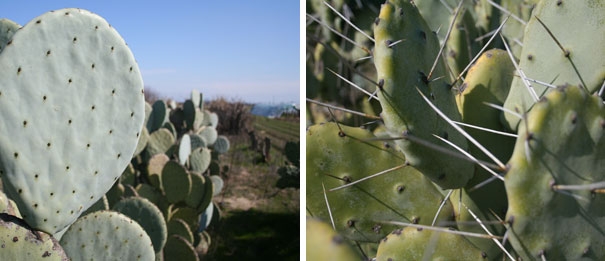
A serious pest of nopales is cochineal scale. Molinar said that, at Kearney, cochnieal was responsible for the failure of several varieties of spineless cacti. The nopales with spines seemed to carry greater resistance to the pest.
"Resistance isn't related to the spines themselves, but something in the genetic makeup," Molinar said. "It was fairly obvious. We did have one or two spineless varieties that weren’t attacked either."
Over the centuries in Central America, cochineal scale was valued as a source of red dye. During the colonial period, cochineal scale was Mexico's second most valued export after silver, however, the development of synthetic pigments reduced demand.
Cooking with nopales
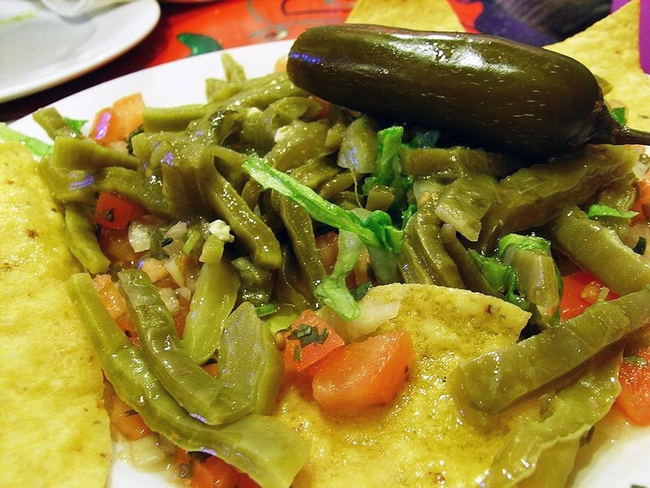
To prepare the pad, hold its base and scape both sides with a blunt knife to remove the spines. Peel the pads and cut them into shoestring strips or small cubes. They can be eaten raw in salads, boiled and fried like eggplant, pickled with spices, or cooked with shellfish, pork, chilies, tomatoes, eggs, coriander, garlic and onions.
For more information, see the UC Small Farm Program's Family Farm Series article on Prickly Pear Cactus Production.
When vegetables become an adventure
Walking through a field lined with row upon row of different vegetables — many ready for the picking — can be an exercise in abundance. When you're faced with the prospects of a huge, just-picked Japanese cabbage or spicy green lo bok pulled fresh from the ground, suddenly vegetables might seem like less of a chore and more of an adventure.
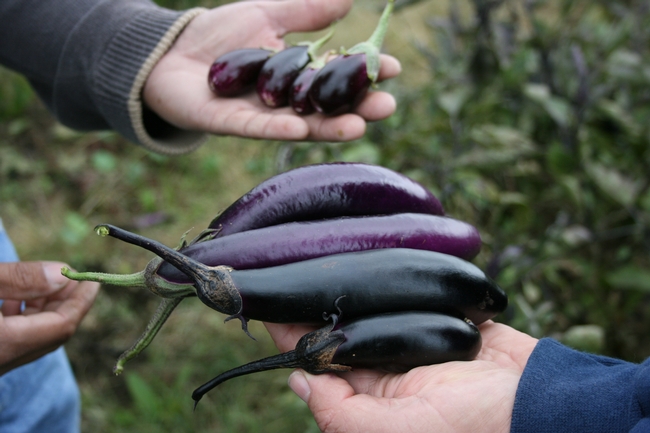
We were visiting the farm to share some new "veggie adventures" that went beyond the four colorful vegetables highlighted in this project (to refresh your memory, the Great Veggie Adventure highlighted Romanesco, rainbow carrots, party cauliflower and watermelon radishes).
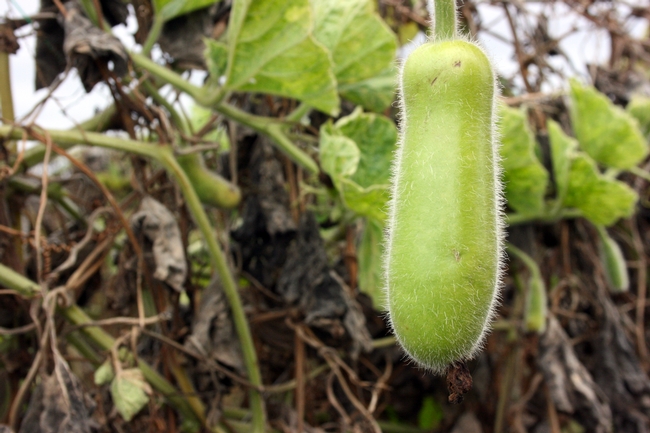
Molinar and Yang showed me many vegetables I had never tried, including moqua, sinqua, long beans, lo bok, opo and winter melon.
"One of the exciting things about this job is you always learn something new," Molinar said. "Our specialty is with the Asian vegetables, with Michael's expertise in that area. Asians have vegetables that are unique to their culture, that they prefer — just like Punjabis have vegetables unique to their culture, and Hispanics have vegetables common to them."
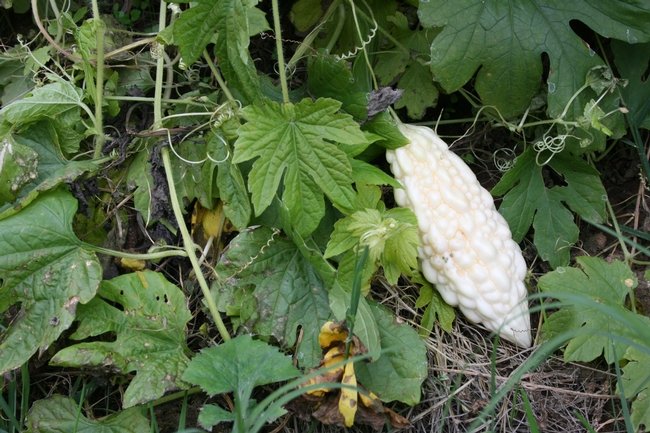
We walked between the trellised crops and up and down the plant rows, while Yang and Molinar picked samples and talked about how to eat these new-to-me vegetables.
Yang pointed out that sometimes Asian vegetables include familiar varieties that are grown and eaten in less familiar ways. For example, many Hmong and Chinese farmers grow sugar snap pea plants for the tender shoots, tendrils and leaves instead of the pea pod.
Make sure to watch our short video from that day:
Still curious?
- Find more information about growing Asian vegetables from the UC Small Farm Program
- Visit the official Great Veggie Adventure website by the makers of Hidden Valley Salad Dressings
- Watch more videos from our Great Veggie Adventure playlist
Put down that zucchini! Pick up the ... bittermelon?
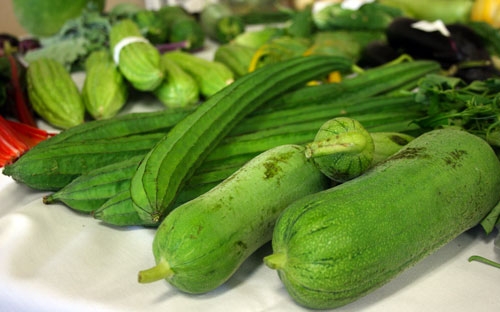
Welcome to August. Are you tired of summer squash yet?
If your dinners have been overflowing with zucchini recently (like mine have), now might be a great time to try new varieties of otherwise familiar vegetables.
One of the farm advisors I work with has long touted some varieties of "Asian vegetables" as more flavorful than their traditionally "American" cousins. Here in the U.S., vegetable varieties like these are more likely to be grown by farmers — and sold to customers — who have close ties to Asian immigrant communities. Richard Molinar, UC Cooperative Extension farm advisor for Fresno County, works frequently with Hmong farmers and says that he now prefers Hmong cucumber and Japanese eggplant to the varieties you might find in most California supermarkets.
After years of hearing Molinar's claims, I finally had a chance to try some of these new-to-me Asian vegetables during lunch at the Hmong Specialty Crops and Medicinal Herbs conference.
Presenters in the morning talked about crops such as sinqua, luffa (photo above has fresh luffa, in angled and smooth varieties), moqua, snake gourd, bittermelon and donqua — all of which are cucurbits, in the gourd family with other squashes and melons. Other Asian vegetables common in some specialty markets include leafy greens and tender shoots from chayote, amaranth, bittermelon, pumpkin, okra leaf, yam leaf, yucca and sour leaf plants. Discussions at the conference focused on these and other specialty crops, including ways to eat them.
"Maybe we need a recipe to teach customers how to buy these new crops," said Chukuo Thao, CEO of National Hmong American Farmers, who alternated between English and Hmong while speaking at the conference.
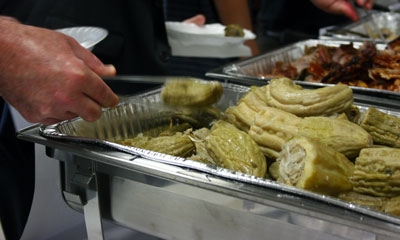
Some of the vegetables and herbs discussed at the conference were highlights of that day's lunch. The menu included a slushy Hmong cucumber drink, purple sticky rice, salsa made with cherry tomatoes, stir-fried mustard greens with pork skin, Hmong herbal chicken soup and steamed bittermelon stuffed with turkey.
But how did it taste? The stuffed bittermelon was what I was most looking forward to trying. The dish was delicious and wow, was it bitter! That is one appropriately named vegetable. Speakers at the conference suggested bitterness is frequently associated with medicinal qualities in Hmong cuisine.
Not all of the lunch dishes were bitter, of course. The cucumber dish was refreshing and very sweet, a dish with eggplant was spicy, and the mustard greens were salty and pungent. Many of the dishes were also made with lemongrass; Fresno County is where most of the nation's lemongrass comes from, according to Molinar in a recent article from the California Ag Network.
Curious about other Asian vegetables? Check out the Small Farm Program's guides to Asian vegetables, along with tips for farmers about how to grow and sell these niche varieties.
Question: The Small Farm Program has a lot of information about different vegetable varieties, but I'm still finding new vegetables to try. What are some of your favorite Asian vegetables?
P.S. While the conference was my first chance to taste bittermelon, Richard Molinar and Gus Schumacher (former USDA undersecretary) were being honored by Hmong community members for their long-time support of Southeast Asian refugee farmers. The two men were each given Hmong names in a special ceremony.
